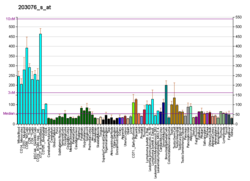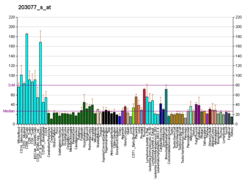Mothers_against_decapentaplegic_homolog_2
Mothers against decapentaplegic homolog 2
Protein found in humans
Mothers against decapentaplegic homolog 2, also known as SMAD family member 2 or SMAD2, is a protein that in humans is encoded by the SMAD2 gene.[5][6] MAD homolog 2 belongs to the SMAD, a family of proteins similar to the gene products of the Drosophila gene 'mothers against decapentaplegic' (Mad) and the C. elegans gene Sma. SMAD proteins are signal transducers and transcriptional modulators that mediate multiple signaling pathways.
SMAD2 mediates the signal of the transforming growth factor (TGF)-beta, and thus regulates multiple cellular processes, such as cell proliferation, apoptosis, and differentiation. This protein is recruited to the TGF-beta receptors through its interaction with the SMAD anchor for receptor activation (SARA) protein. In response to TGF-beta signal, this protein is phosphorylated by the TGF-beta receptors. The phosphorylation induces the dissociation of this protein with SARA and the association with the family member SMAD4. The association with SMAD4 is important for the translocation of this protein into the cell nucleus, where it binds to target promoters and forms a transcription repressor complex with other cofactors. This protein can also be phosphorylated by activin type 1 receptor kinase, and mediates the signal from the activin. Alternatively spliced transcript variants encoding the same protein have been observed.[7]
Like other Smads, Smad2 plays a role in the transmission of extracellular signals from ligands of the Transforming Growth Factor beta (TGFβ) superfamily of growth factors into the cell nucleus. Binding of a subgroup of TGFβ superfamily ligands to extracellular receptors triggers phosphorylation of Smad2 at a Serine-Serine-Methionine-Serine (SSMS) motif at its extreme C-terminus. Phosphorylated Smad2 is then able to form a complex with Smad4. These complexes accumulate in the cell nucleus, where they are directly participating in the regulation of gene expression.
The SMAD proteins are homologs of both the drosophila protein, mothers against decapentaplegic (MAD) and the C. elegans protein SMA. The name is a combination of the two. During Drosophila research, it was found that a mutation in the gene MAD in the mother repressed the gene decapentaplegic in the embryo. The phrase "Mothers against" was added, since mothers often form organizations opposing various issues, e.g., Mothers Against Drunk Driving, or (MADD). The nomenclature for this protein is based on a tradition of such unusual naming within the gene research community.[8]
Mothers against decapentaplegic homolog 2 has been shown to interact with:
- "Human PubMed Reference:". National Center for Biotechnology Information, U.S. National Library of Medicine.
- "Mouse PubMed Reference:". National Center for Biotechnology Information, U.S. National Library of Medicine.
- Eppert K, Scherer SW, Ozcelik H, Pirone R, Hoodless P, Kim H, Tsui LC, Bapat B, Gallinger S, Andrulis IL, Thomsen GH, Wrana JL, Attisano L (August 1996). "MADR2 maps to 18q21 and encodes a TGFbeta-regulated MAD-related protein that is functionally mutated in colorectal carcinoma". Cell. 86 (4): 543–52. doi:10.1016/S0092-8674(00)80128-2. PMID 8752209. S2CID 531842.
- "Sonic Hedgehog, DICER, and the Problem With Naming Genes", Sep 26, 2014, Michael White. psmag.com
- Nourry C, Maksumova L, Pang M, Liu X, Wang T (May 2004). "Direct interaction between Smad3, APC10, CDH1 and HEF1 in proteasomal degradation of HEF1". BMC Cell Biol. 5: 20. doi:10.1186/1471-2121-5-20. PMC 420458. PMID 15144564.
- Hocevar BA, Smine A, Xu XX, Howe PH (June 2001). "The adaptor molecule Disabled-2 links the transforming growth factor β receptors to the Smad pathway". EMBO J. 20 (11): 2789–801. doi:10.1093/emboj/20.11.2789. ISSN 0261-4189. PMC 125498. PMID 11387212.
- Wotton D, Lo RS, Lee S, Massagué J (April 1999). "A Smad transcriptional corepressor". Cell. 97 (1): 29–39. doi:10.1016/S0092-8674(00)80712-6. ISSN 0092-8674. PMID 10199400. S2CID 6907878.
- Pessah M, Prunier C, Marais J, Ferrand N, Mazars A, Lallemand F, Gauthier JM, Atfi A (May 2001). "c-Jun interacts with the corepressor TG-interacting factor (TGIF) to suppress Smad2 transcriptional activity". Proc. Natl. Acad. Sci. U.S.A. 98 (11): 6198–203. Bibcode:2001PNAS...98.6198P. doi:10.1073/pnas.101579798. ISSN 0027-8424. PMC 33445. PMID 11371641.
- Liu B, Dou CL, Prabhu L, Lai E (January 1999). "FAST-2 Is a Mammalian Winged-Helix Protein Which Mediates Transforming Growth Factor β Signals". Mol. Cell. Biol. 19 (1): 424–30. doi:10.1128/MCB.19.1.424. ISSN 0270-7306. PMC 83900. PMID 9858566.
- Liu F, Pouponnot C, Massagué J (December 1997). "Dual role of the Smad4/DPC4 tumor suppressor in TGFβ-inducible transcriptional complexes". Genes Dev. 11 (23): 3157–67. doi:10.1101/gad.11.23.3157. ISSN 0890-9369. PMC 316747. PMID 9389648.
- Dou C, Lee J, Liu B, Liu F, Massague J, Xuan S, Lai E (September 2000). "BF-1 Interferes with Transforming Growth Factor β Signaling by Associating with Smad Partners". Mol. Cell. Biol. 20 (17): 6201–11. doi:10.1128/MCB.20.17.6201-6211.2000. ISSN 0270-7306. PMC 86095. PMID 10938097.
- O'Neill TJ, Zhu Y, Gustafson TA (April 1997). "Interaction of MAD2 with the carboxyl terminus of the insulin receptor but not with the IGFIR. Evidence for release from the insulin receptor after activation". J. Biol. Chem. 272 (15): 10035–40. doi:10.1074/jbc.272.15.10035. ISSN 0021-9258. PMID 9092546.
- Labbé E, Letamendia A, Attisano L (July 2000). "Association of Smads with lymphoid enhancer binding factor 1/T cell-specific factor mediates cooperative signaling by the transforming growth factor-β and Wnt pathways". Proc. Natl. Acad. Sci. U.S.A. 97 (15): 8358–63. Bibcode:2000PNAS...97.8358L. doi:10.1073/pnas.150152697. ISSN 0027-8424. PMC 26952. PMID 10890911.
- Feng XH, Liang YY, Liang M, Zhai W, Lin X (January 2002). "Direct interaction of c-Myc with Smad2 and Smad3 to inhibit TGF-beta-mediated induction of the CDK inhibitor p15(Ink4B)". Mol. Cell. 9 (1): 133–43. doi:10.1016/S1097-2765(01)00430-0. ISSN 1097-2765. PMID 11804592.
- Quinn ZA, Yang CC, Wrana JL, McDermott JC (February 2001). "Smad proteins function as co-modulators for MEF2 transcriptional regulatory proteins". Nucleic Acids Res. 29 (3): 732–42. doi:10.1093/nar/29.3.732. PMC 30396. PMID 11160896.
- Long J, Wang G, Matsuura I, He D, Liu F (January 2004). "Activation of Smad transcriptional activity by protein inhibitor of activated STAT3 (PIAS3)". Proc. Natl. Acad. Sci. U.S.A. 101 (1): 99–104. Bibcode:2004PNAS..101...99L. doi:10.1073/pnas.0307598100. ISSN 0027-8424. PMC 314145. PMID 14691252.
- Nakano A, Koinuma D, Miyazawa K, Uchida T, Saitoh M, Kawabata M, Hanai J, Akiyama H, Abe M, Miyazono K, Matsumoto T, Imamura T (March 2009). "Pin1 down-regulates transforming growth factor-beta (TGF-beta) signaling by inducing degradation of Smad proteins". J. Biol. Chem. 284 (10): 6109–15. doi:10.1074/jbc.M804659200. ISSN 0021-9258. PMID 19122240.
- Harada J, Kokura K, Kanei-Ishii C, Nomura T, Khan MM, Kim Y, Ishii S (October 2003). "Requirement of the co-repressor homeodomain-interacting protein kinase 2 for ski-mediated inhibition of bone morphogenetic protein-induced transcriptional activation". J. Biol. Chem. 278 (40): 38998–9005. doi:10.1074/jbc.M307112200. ISSN 0021-9258. PMID 12874272.
- Luo K, Stroschein SL, Wang W, Chen D, Martens E, Zhou S, Zhou Q (September 1999). "The Ski oncoprotein interacts with the Smad proteins to repress TGFβ signaling". Genes Dev. 13 (17): 2196–206. doi:10.1101/gad.13.17.2196. ISSN 0890-9369. PMC 316985. PMID 10485843.
- Stroschein SL, Bonni S, Wrana JL, Luo K (November 2001). "Smad3 recruits the anaphase-promoting complex for ubiquitination and degradation of SnoN". Genes Dev. 15 (21): 2822–36. doi:10.1101/gad.912901. ISSN 0890-9369. PMC 312804. PMID 11691834.
- Stroschein SL, Wang W, Zhou S, Zhou Q, Luo K (October 1999). "Negative feedback regulation of TGF-beta signaling by the SnoN oncoprotein". Science. 286 (5440): 771–4. doi:10.1126/science.286.5440.771. ISSN 0036-8075. PMID 10531062.
- Nakao A, Imamura T, Souchelnytskyi S, Kawabata M, Ishisaki A, Oeda E, Tamaki K, Hanai J, Heldin CH, Miyazono K, ten Dijke P (September 1997). "TGF-beta receptor-mediated signalling through Smad2, Smad3 and Smad4". EMBO J. 16 (17): 5353–62. doi:10.1093/emboj/16.17.5353. ISSN 0261-4189. PMC 1170167. PMID 9311995.
- Lebrun JJ, Takabe K, Chen Y, Vale W (January 1999). "Roles of pathway-specific and inhibitory Smads in activin receptor signaling". Mol. Endocrinol. 13 (1): 15–23. doi:10.1210/mend.13.1.0218. ISSN 0888-8809. PMID 9892009. S2CID 26825706.
- Lin X, Liang M, Feng XH (November 2000). "Smurf2 is a ubiquitin E3 ligase mediating proteasome-dependent degradation of Smad2 in transforming growth factor-beta signaling". J. Biol. Chem. 275 (47): 36818–22. doi:10.1074/jbc.C000580200. ISSN 0021-9258. PMID 11016919.
- Leong GM, Subramaniam N, Figueroa J, Flanagan JL, Hayman MJ, Eisman JA, Kouzmenko AP (May 2001). "Ski-interacting protein interacts with Smad proteins to augment transforming growth factor-beta-dependent transcription". J. Biol. Chem. 276 (21): 18243–8. doi:10.1074/jbc.M010815200. ISSN 0021-9258. PMID 11278756.
- Datta PK, Moses HL (May 2000). "STRAP and Smad7 Synergize in the Inhibition of Transforming Growth Factor β Signaling". Mol. Cell. Biol. 20 (9): 3157–67. doi:10.1128/MCB.20.9.3157-3167.2000. ISSN 0270-7306. PMC 85610. PMID 10757800.
- Wrana JL (1998). "TGF-beta receptors and signalling mechanisms". Mineral and Electrolyte Metabolism. 24 (2–3): 120–30. doi:10.1159/000057359. PMID 9525694. S2CID 84458561.
- Massagué J (1998). "TGF-beta signal transduction". Annu. Rev. Biochem. 67: 753–91. doi:10.1146/annurev.biochem.67.1.753. PMID 9759503.
- Verschueren K, Huylebroeck D (2000). "Remarkable versatility of Smad proteins in the nucleus of transforming growth factor-beta activated cells". Cytokine Growth Factor Rev. 10 (3–4): 187–99. doi:10.1016/S1359-6101(99)00012-X. PMID 10647776.
- Wrana JL, Attisano L (2000). "The Smad pathway". Cytokine Growth Factor Rev. 11 (1–2): 5–13. doi:10.1016/S1359-6101(99)00024-6. PMID 10708948.
- Miyazono K (2000). "TGF-beta signaling by Smad proteins". Cytokine Growth Factor Rev. 11 (1–2): 15–22. doi:10.1016/S1359-6101(99)00025-8. PMID 10708949.
- Zannis VI, Kan HY, Kritis A, Zanni E, Kardassis D (March 2001). "Transcriptional regulation of the human apolipoprotein genes". Front. Biosci. 6: D456–504. doi:10.2741/Zannis. PMID 11229886.
This article incorporates text from the United States National Library of Medicine, which is in the public domain.







